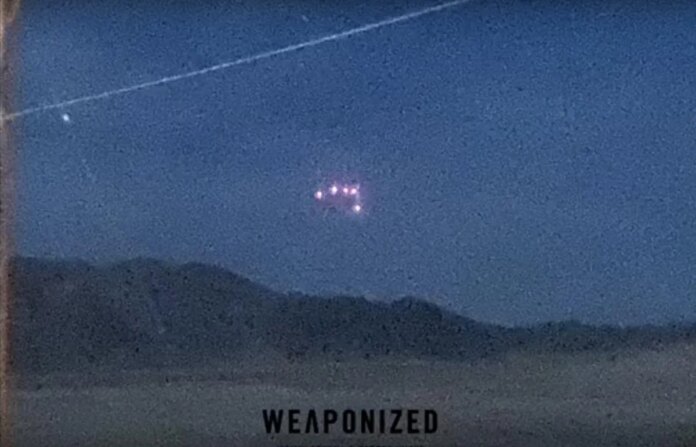On Amazon, you can buy a fake degree in Ufology.
The novelty certificate sells for $13.99, or what a head of lettuce will cost in a month. The idea of earning a “Doctorate of Ufology” from “Ufologist State University” is a gag steeped in decades of stigma, during which any expressed interest in UFOs was sure to land you in a cray-cray banquet hall with Bigfoot and Loch Ness enthusiasts.
But faster than you can say “Fox Mulder,” the stigma has crashed and burned.
In recent years, the U.S. government has shifted away from its Top Secret factory default and is at least open to the possibility that strange craft of unknown origin are buzzing its airspace while violating all known laws of physics. We’ve had front page stories in the New York Times and code-named videos — “FLIR,” “GIMBAL,” “GOFAST” — witnessed by navy pilots and recorded by tracking systems on advanced fighter jets.
Now the question becomes: When will universities get serious about UFOs?
A research paper, published this week in the journal Humanities and Social Science Communications, found that nearly 20 per cent of American academics have either seen a UFO or know someone who has. Faculty from 14 disciplines across 144 universities were surveyed for the paper. As the authors wrote, “Results demonstrated that faculty think the academic evaluation of UAP (Unidentified Anomalous Phenomena) information and more academic research on this topic is important. Curiosity outweighed skepticism or indifference.”
It’s about time. And if academics are looking for research ideas, they might start by watching Tuesday’s episode of the “Weaponized” podcast. It is co-hosted by Jeremy Corbell and George Knapp, two investigative journalists who are to ufology as Einstein was to the theory of relativity. I have privately joked with Corbell, the director of “Bob Lazar: Area 51 & Flying Saucers,” that he gets name-checked in this column more than any Kardashian. What can I tell you? Jeremy just keeps digging up the skies.
His latest scoop? Corbell was tipped off about a curious sighting in 2021. It took place at the Twentynine Palms military base in California. Dozens of marines “watched in awe as a massive, triangular-shaped object sat motionless in the sky for a period of more than 10 minutes. Several marines recorded images of the triangle on their cellphones, including phones equipped with low light features.”
Those images, and eyewitness audio, were shared on “Weaponized.”
The object was described as the size of a two-storey house, if that home was the length of half a football field. It hovered in eerie silence with no visible means of propulsion. Then when flares were fired at it so the humans could get a better look, it vanished.
Poof. Gone as fast as an edible in the mouth of Mike Tyson.
Before skeptics dismiss this with bird, weather balloon or traffic light explanations, they might ask why military choppers and a truck convoy were dispatched to find the mystery craft. And they might wonder why, in recent days, commercial flights were briefly suspended in both Taiwan and Turkey after unexplained sightings.
It was once easy to tolerate the stigma as it relates to UFOs and the education system. In high school, when I sheepishly asked an English teacher if I could devote my yearlong independent study project to UFOs, I knew she would instantly believe I was a kook. But she had an open mind. And that school year, when I should have been up to my eyes in Hemingway or Tolstoy, I instead did a deep dive into Roswell, Kenneth Arnold, Green Fireballs, Barney and Betty Hill, Project Blue Book, Travis Walton, the Berkshire Sightings, the 1976 Tehran Encounter, weird incursions over nuclear bases in Russia …
Now, obviously, we should not ditch chemistry or history to focus on UFOs. We have serious issues on this planet worthy of ongoing research. But is there no room in the Ivory Tower for a mother ship? If universities can offer courses in bowling management or the gender politics of “Peanuts,” why can’t our deepest thinkers figure out, A) What on earth is that overhead? And, B) Is it from Earth?
I keep hearing the experts say the UFO phenomenon is about national security. It’s actually about planetary security. There are sightings every month, in every part of the world, of objects we can’t identity that exhibit aerial manoeuvres that make our most sophisticated aircraft seem like helium balloons. More than 50 U.S. marines witnessed a triangular object with five lights float above Camp Wilson for 10 minutes?
This sounds like something the academics should be investigating.
And now that we have foolishly released the artificial intelligence genie from the bottle, why not harness the power of supercomputing for research? When I watched “Weaponized” on Tuesday, I was struck by similarities to the Hudson Valley sightings of the ’80s and the so-called Phoenix Lights incident in 1997.
And I am a total moron. Imagine what correlations AI might generate if it is fed the data sets of every UFO sighting in recorded history. Why is there a spike of sightings coming out of oceans? Why do navy videos show crafts travelling belly first, exactly as Bob Lazar described in 1989? Can gravity and space be manipulated?
These are questions governments are finally taking seriously.
Now it is time for universities to ditch the fake degrees and get real.
JOIN THE CONVERSATION
does not endorse these opinions.


